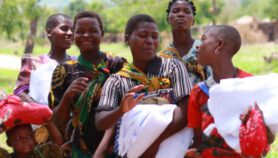Send to a friend
The details you provide on this page will not be used to send unsolicited email, and will not be sold to a 3rd party. See privacy policy.
Africa ‘winning sleeping sickness battle’
A new report from the International Scientific Council for Trypanosomiasis Research and Control says the continent appears to be defeating sleeping sickness through effective aerial spraying and localised insecticide use. It praises the Pan African Tsetse and Trypanosomiasis Eradication Campaign established in 2000. More>> *
Kenyan public health and population research project gets boost
The Consortium for Advanced Research Training in Africa (CARTA) — a programme of the Kenya-based African Population and Health Research Center — has received a US$5.7 million grant from the Wellcome Trust to boost research capacity in African universities. Some of CARTA’s goals include building world-class research groups and creating practical mechanisms for networking researchers. More>>
African presidents plan new malaria alliance
African leaders have agreed on a programme to place malaria high on the continent’s political agenda. The African Leaders Malaria Initiative was launched at the sidelines of the UN General Assembly’s annual meeting. Its goal is to provide all "at-risk Africans" with access to malaria control methods by the end of 2010. More>>
Digital tool counts malaria parasites
A paper published in Malaria Journal reports that by using open-access software, scientists were able to accurately quantify malaria parasite densities in patient blood samples — an important method in laboratory diagnosis of the disease. The method was particularly successful for the high densities that are normally difficult to measure using standard counting techniques. More>> ![]() [257kB]
[257kB]
Non-communicable disease burden in South Africa to rise
A paper published in The Lancet indicates that non-communicable diseases are putting increasing pressure on South Africa’s health systems and as antiretrovirals extend lives the burden is likely to increase. To tackle this, the district-based primary healthcare system must be strengthened, the authors say. More>> *
HIV spread in Central and East Africa explained
Researchers in the US have used databases and DNA samples to explain why two subtypes of HIV-1 virus remained at steadily low levels in west and central Africa but caused an epidemic in the east. They say that in East Africa, travelling from city to city is easier whereas in the Democratic Republic of Congo, from where HIV spread to the east, cities are more isolated. More>>
South Africa water shortage may delay infrastructure projects
South Africa may be forced to put on hold several development projects, including mines and power stations, after a new report revealed the country has dwindling water resources. The study, conducted for the national water commission, found that South Africa has four per cent less surface and underground water resources than estimated in 1995. More>>
Schoolchildren least protected from malaria in Kenya
New research conducted in Kenya has found that school-age children are at a higher risk of contracting malaria as they are less likely than children under five to have access to an insect treated mosquito net (ITN). The researchers, writing in BMC Public Health say this is because ITNs tend to be targeted towards the most vulnerable groups — children aged five and under, and pregnant women. More>> ![]()
![]()
![]()
![]()
![]()
*Free registration is required to view this article
Compiled by Kimani Chege. Additional reporting by Alex Abutu.
If you would like to suggest a story for this news in brief, please email [email protected]













